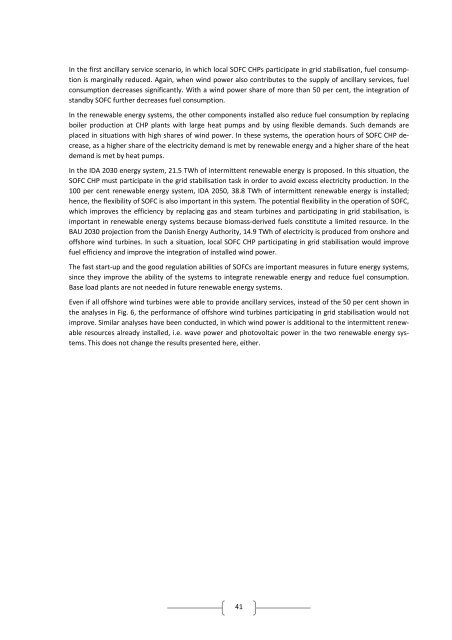Fuel cells and electrolysers in future energy systems - VBN
Fuel cells and electrolysers in future energy systems - VBN
Fuel cells and electrolysers in future energy systems - VBN
You also want an ePaper? Increase the reach of your titles
YUMPU automatically turns print PDFs into web optimized ePapers that Google loves.
In the first ancillary service scenario, <strong>in</strong> which local SOFC CHPs participate <strong>in</strong> grid stabilisation, fuel consump‐<br />
tion is marg<strong>in</strong>ally reduced. Aga<strong>in</strong>, when w<strong>in</strong>d power also contributes to the supply of ancillary services, fuel<br />
consumption decreases significantly. With a w<strong>in</strong>d power share of more than 50 per cent, the <strong>in</strong>tegration of<br />
st<strong>and</strong>by SOFC further decreases fuel consumption.<br />
In the renewable <strong>energy</strong> <strong>systems</strong>, the other components <strong>in</strong>stalled also reduce fuel consumption by replac<strong>in</strong>g<br />
boiler production at CHP plants with large heat pumps <strong>and</strong> by us<strong>in</strong>g flexible dem<strong>and</strong>s. Such dem<strong>and</strong>s are<br />
placed <strong>in</strong> situations with high shares of w<strong>in</strong>d power. In these <strong>systems</strong>, the operation hours of SOFC CHP de‐<br />
crease, as a higher share of the electricity dem<strong>and</strong> is met by renewable <strong>energy</strong> <strong>and</strong> a higher share of the heat<br />
dem<strong>and</strong> is met by heat pumps.<br />
In the IDA 2030 <strong>energy</strong> system, 21.5 TWh of <strong>in</strong>termittent renewable <strong>energy</strong> is proposed. In this situation, the<br />
SOFC CHP must participate <strong>in</strong> the grid stabilisation task <strong>in</strong> order to avoid excess electricity production. In the<br />
100 per cent renewable <strong>energy</strong> system, IDA 2050, 38.8 TWh of <strong>in</strong>termittent renewable <strong>energy</strong> is <strong>in</strong>stalled;<br />
hence, the flexibility of SOFC is also important <strong>in</strong> this system. The potential flexibility <strong>in</strong> the operation of SOFC,<br />
which improves the efficiency by replac<strong>in</strong>g gas <strong>and</strong> steam turb<strong>in</strong>es <strong>and</strong> participat<strong>in</strong>g <strong>in</strong> grid stabilisation, is<br />
important <strong>in</strong> renewable <strong>energy</strong> <strong>systems</strong> because biomass‐derived fuels constitute a limited resource. In the<br />
BAU 2030 projection from the Danish Energy Authority, 14.9 TWh of electricity is produced from onshore <strong>and</strong><br />
offshore w<strong>in</strong>d turb<strong>in</strong>es. In such a situation, local SOFC CHP participat<strong>in</strong>g <strong>in</strong> grid stabilisation would improve<br />
fuel efficiency <strong>and</strong> improve the <strong>in</strong>tegration of <strong>in</strong>stalled w<strong>in</strong>d power.<br />
The fast start‐up <strong>and</strong> the good regulation abilities of SOFCs are important measures <strong>in</strong> <strong>future</strong> <strong>energy</strong> <strong>systems</strong>,<br />
s<strong>in</strong>ce they improve the ability of the <strong>systems</strong> to <strong>in</strong>tegrate renewable <strong>energy</strong> <strong>and</strong> reduce fuel consumption.<br />
Base load plants are not needed <strong>in</strong> <strong>future</strong> renewable <strong>energy</strong> <strong>systems</strong>.<br />
Even if all offshore w<strong>in</strong>d turb<strong>in</strong>es were able to provide ancillary services, <strong>in</strong>stead of the 50 per cent shown <strong>in</strong><br />
the analyses <strong>in</strong> Fig. 6, the performance of offshore w<strong>in</strong>d turb<strong>in</strong>es participat<strong>in</strong>g <strong>in</strong> grid stabilisation would not<br />
improve. Similar analyses have been conducted, <strong>in</strong> which w<strong>in</strong>d power is additional to the <strong>in</strong>termittent renew‐<br />
able resources already <strong>in</strong>stalled, i.e. wave power <strong>and</strong> photovoltaic power <strong>in</strong> the two renewable <strong>energy</strong> sys‐<br />
tems. This does not change the results presented here, either.<br />
41

















